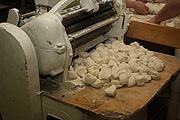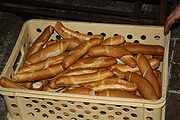Kifli
 Two kiflis, the left one is salted | |
| Course | Dessert |
|---|---|
| Place of origin | Hungary, Serbia |
| Region or state | Balkan, Central Europe |
| Serving temperature | Cooked |
| Main ingredients | Yeast |
Kifli (Hungarian pronunciation: [ˈkifli]) is a traditional Hungarian, Austrian (Kipferl), Serbian (кифла/kifla), Bosnian (kifla), Macedonian (кифла), Bulgarian (кифла) Czech (rohlík), Slovak (rožok) and Polish (rogal) yeast roll made into a crescent shape.[1][2]
Method
A "kifli" is made by cutting sheets of soft yeast dough into triangular wedges, and rolling up those wedges to form a crescent shape which is then baked. "Kifli" differs from the French "croissant" (the word means "kifli") in that it is made from a plain, bread-like dough (thus being more akin to a roll than to pastry) and being both thinner and longer. They may also come in different sizes, some of them equalling in weight a small bread loaf.
Regular
The rolls of dough can be left plain or given a water brushing as they come out of the oven to make them shiny, or given an egg wash and sprinkled with either poppy seeds or caraway seeds mixed with coarse salt. The latter variety is often made into a straight shape, instead of curved like a crescent. "Kifli" is eaten like bread or rolls, usually made into a sandwich, sometimes plain or with butter like fresh baguette. Often, especially for breakfast, the topping is jam or honey, or used for dunking.
Fine
Same as regular but the dough may contain butter or other shortening and/or milk. It has a sweeter flavor than the regular variety and is therefore especially well suited to be eaten with jam or honey, as is often done for breakfast with coffee, hot chocolate or milk.
Sweets
There are a couple of sweets that carry the name "kifli" to describe their shape but they are eaten at the end of a meal or with an afternoon tea or coffee and have nothing to do with "kifli" which, if the word is used on its own, always means the regular or fine varieties described above.
- vaníliás kifli is a small soft cookie made from a dough of ground nuts, instead of flour. It is usually made with walnuts but almonds are more often used outside of Hungary. Once baked they are rolled in vanilla flavored confectioners' sugar before allowed to cool.
- diós kifli, mákos kifli, also known as Pozsonyi kifli (Pozsony is the Hungarian name of Bratislava, capital city of the Slovak Republic) are crescent shaped sweet levened pastries filled with a sweet walnut or poppy paste. They are a variety of beigli, very similar in flavor but different in shape and size.
Origin
A common culinary myth claims that when Christian forces freed Buda from Ottoman occupation in 1686 the bakers of the town celebrated the victory the next day by selling freshly baked bread rolls made into a crescent shape. The fashion caught on, the "kifli" was born. This however has been refuted by historian Karl Teply in 1985.
Trivia
An early 1990s Hungarian pop group Kifli was named after this bakery specialty.
Process of kifli production
- Process of kifli production
-
1/12
-
2/12
-
3/12
-
4/12
-
5/12
-
6/12
-
7/12
-
8/12
-
9/12
-
10/12
-
11/12
-
12/12
See also
- Vanillekipferl a feature of Austrian cuisine
- Rogal świętomarciński, a crescent cake baked in Poznań, Poland, for St. Martin's Day












